San-J Family
Enter Our Contest!
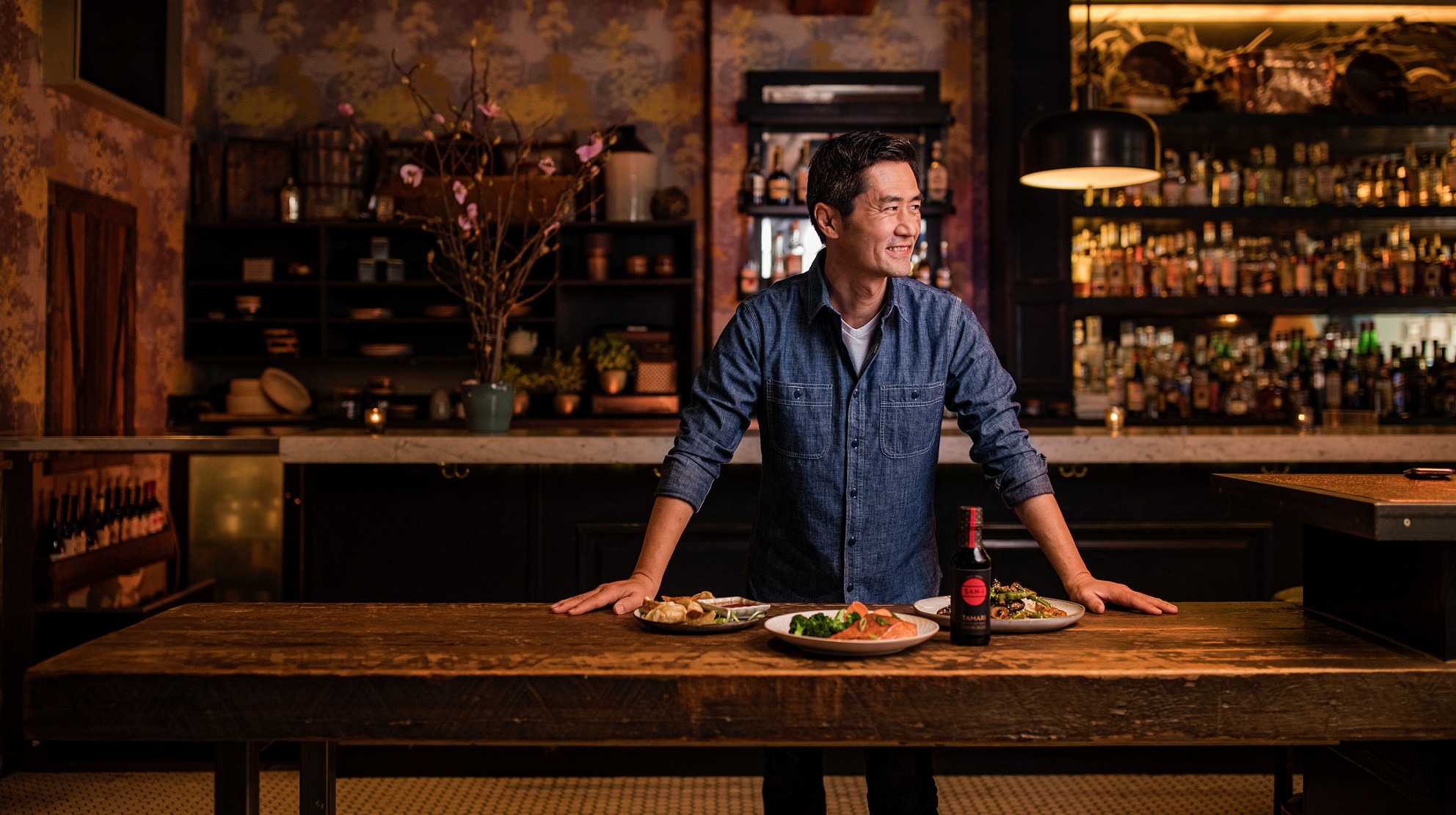
Written by: San-J Posted on: February 15, 2021

Here at San-J, providing high-quality products that our customers can trust has always been a top priority and that mission remains the same during this challenging time. For our product safety, as always, we follow current best practices for manufacturing, federal and local laws, and compliance guidelines on our production floor. In order to provide enhanced protection to our customers and our staff, we have implemented additional cleaning routines within our facilities.
We’ve also increased health precautions among our staff, such as significantly restricting travel and requiring office employees to work from home if possible. For our production staff, we’ve altered our manufacturing set up for their safety and to align with social distancing recommendations from the federal government, but also in a way that we are still able to carefully monitor our fermentation process and continue producing our sauces.
We would like to help you by not only continuing to provide you with the same high-quality products but also by giving you helpful information during this challenging time such as easy recipes, useful food and health tips, and more on our blog. Let us know if you have any questions or if there is a way we can assist you further.
Our thoughts remain with all those who have been affected by this illness all over the world. We want to thank all the people who are working hard to provide care to the afflicted and those in essential positions that work to keep our lives going through this difficult time, including all workers in the medical, food, utility, technology, transportation, and other industries.
We are all in this together and we will get through this. San-J is here to help if you need it – simply fill out our contact form or give us a call.
October is Non-GMO Month, and we’re celebrating with an exciting giveaway!
On Halloween, we’ll select five lucky winners who will receive a San-J Travel Pack of our premium Tamari Soy Sauce, a to-go carrying case, and a canvas tote bag.
To enter, follow @sanjtamari on Instagram and comment on our giveaway post. For an extra entry, share our post to your Story. Giveaway closes at 11:59 pm on Monday, October 29, so get your entry in by then!
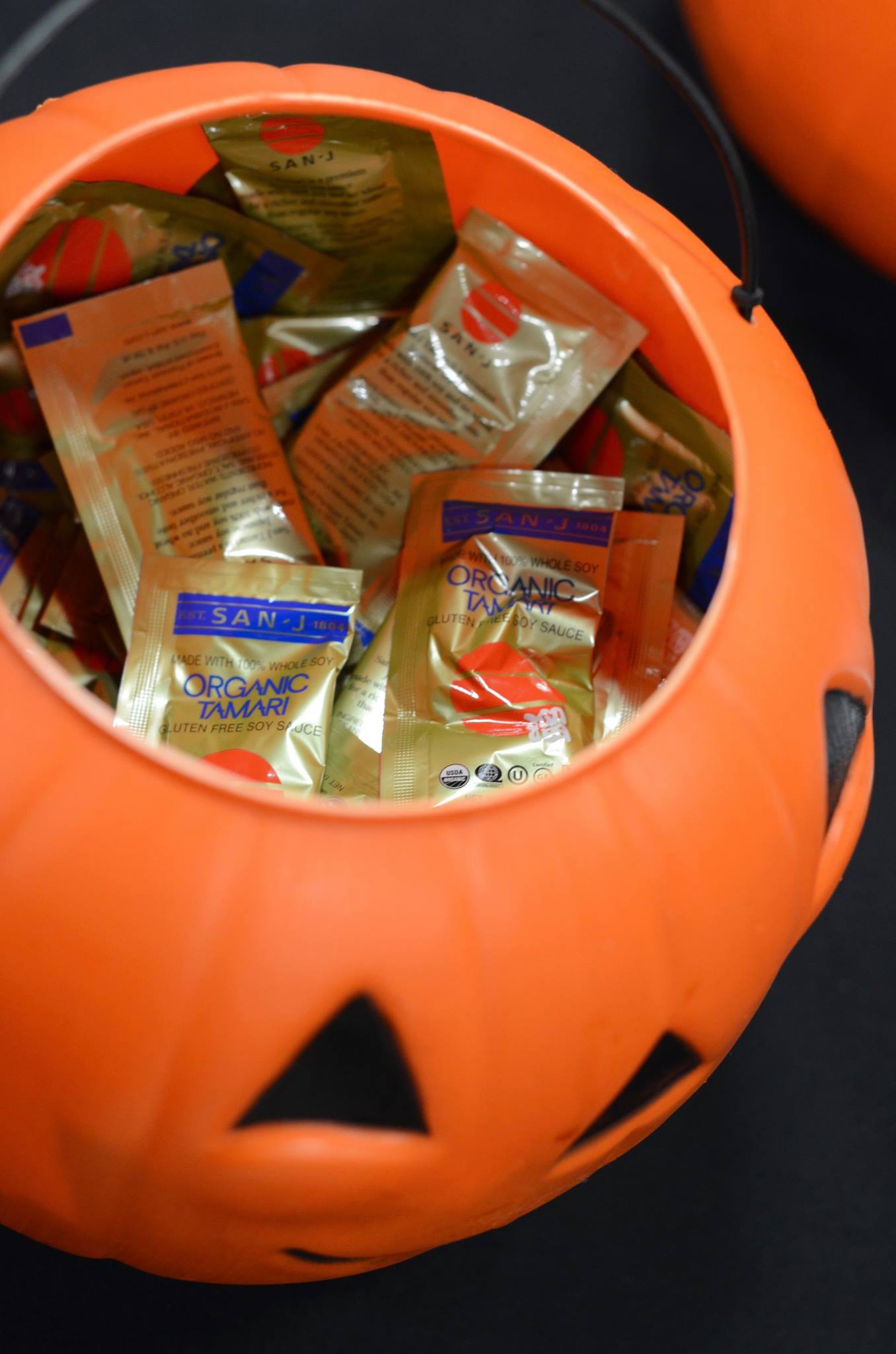
We’re excited to share these packets of gold with you. They’re backed by certifications and a fermentation process to bring you the finest quality soy sauce.
Enter our giveaway today and let us know who you’d share your Tamari packets with!
Every year, we look forward to participating in DC’s Around the World Embassy Tour. Again this year, we joined the Embassy of Japan and over 50 other embassies to share a cultural experience with thousands of attendees. Participants can get the feel of traveling the world through food, art, dance, and music of the different countries. And admission is free!
Upon arrival there were volunteers of every ethnicity. San-J President, Takashi Sato, was at the front of the gate moving around greeting friendly volunteers with appreciation. At 8 am the Japanese Embassy opened up to the volunteers of the event, quickly allowing access and making sure to keep the public to the side. We had two hours to get set up and ready to go!
All volunteers filtered in and quickly began greeting one another. The experienced volunteers who’ve helped in the past began rapidly collecting a San-J Tamari Bottle shirt, which was raved about throughout the day, and moved to their assigned areas for assistance in setup. All new volunteers followed suit.
Takashi went around throughout the crowd of volunteers making sure to greet everyone and assist anyone who needed it. All volunteers after initial setup of food, drinks, origami, and calligraphy stations came to me. I then greeted many unfamiliar but friendly faces of volunteers and gave them the stations that they were assigned to and any instructions needed.
In addition to assigning responsibilities, I wanted to make sure everyone had become aquatinted with each other. Everyone quickly greeted and found much common ground amongst themselves, which was inspirational, for the event hadn’t even began and diversity had already been overcome.
All volunteers prepped and held their breath for the crowd of hundreds of people already beginning to form a line around the Japanese Embassy.
At 10am promptly the Japanese Embassy reopened its gate for the public, which flooded in to be security checked and welcomed into the Embassy house itself.
Once through the Japanese Embassy house, the crowd wandered its way back out onto the other side of courtyard where the volunteers were prepared.
The crowd loved the grilled Tamari corn seasoned with San-J Tamari Soy Sauce. Many were pleasantly surprised after initially thinking they were being handed plain grilled corn.
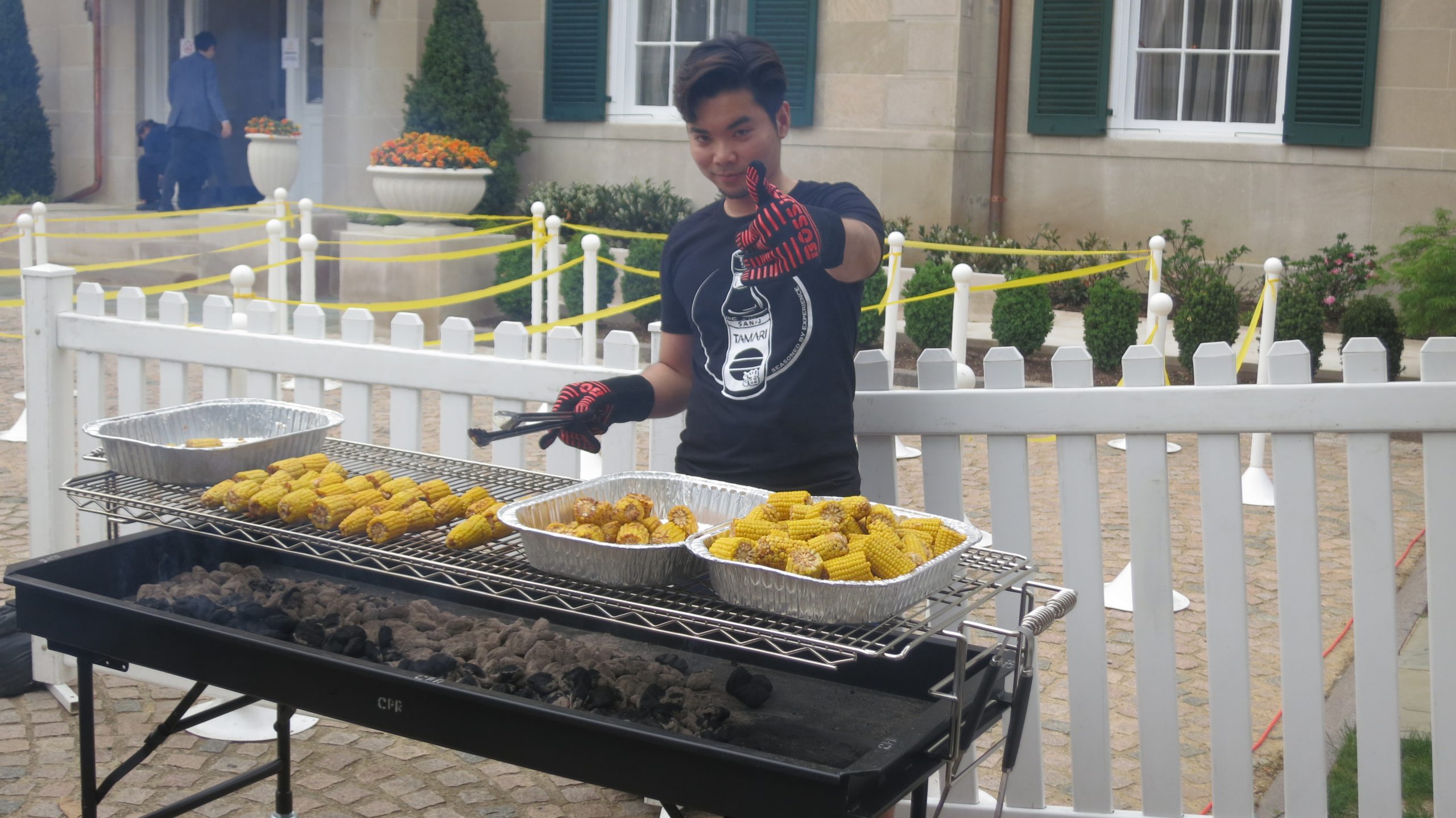
The much-loved traditional grilled teriyaki chicken had many pointing out that’s what they were counting on after enjoying it at this same event in previous years. New comers agreed that it was a tradition many expected and loved about the Japanese cuisine. Check out San-J Teriyaki sauce to make your own at home!
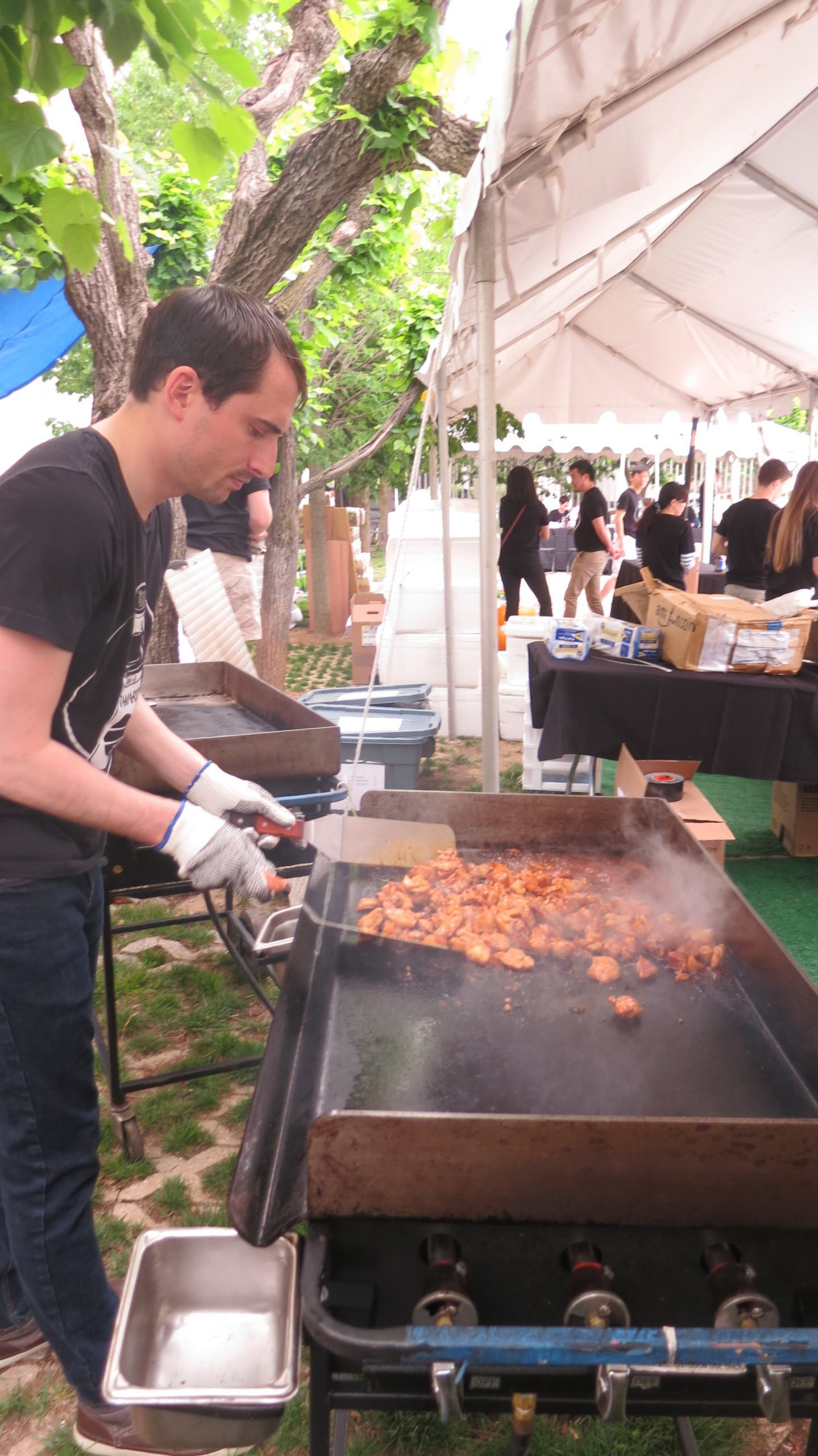
As the crowds, trickled down the line to the mochi ice cream, many exclaimed “MOCHI, I love this stuff!” or “My favorite!” Those who were unfamiliar with this delicacy quickly fell in love with its deliciousness.
Finally, the popcorn! Many people love popcorn, a food known around many countries eaten in various customs. But the majority of the crowd was new to this fantastic Japanese version… Tamari Popcorn. The ingredients were simple but fantastic together: dry organic Tamari powder and freshly popped popcorn. So many loved this combo that they continuously came back for more or fervently encouraged others to go and try this deliciousness.
It was so much fun sharing how achievable Japanese cuisine is. San-J Tamari Soy Sauces and Asian Cooking Sauces really do most of the work achieving the authentic flavor profiles!
The origami and calligraphy station gathered many children and adults alike.
Children and adults watched in amazement as volunteers demonstrated how to make cranes and other creatures with brightly colored origami paper. Each gave their own hand at replicating these beautiful hand-crafted animals- some in success and exuberance of accomplishment and others in a tried but respectful awe that this task is harder than it looks.
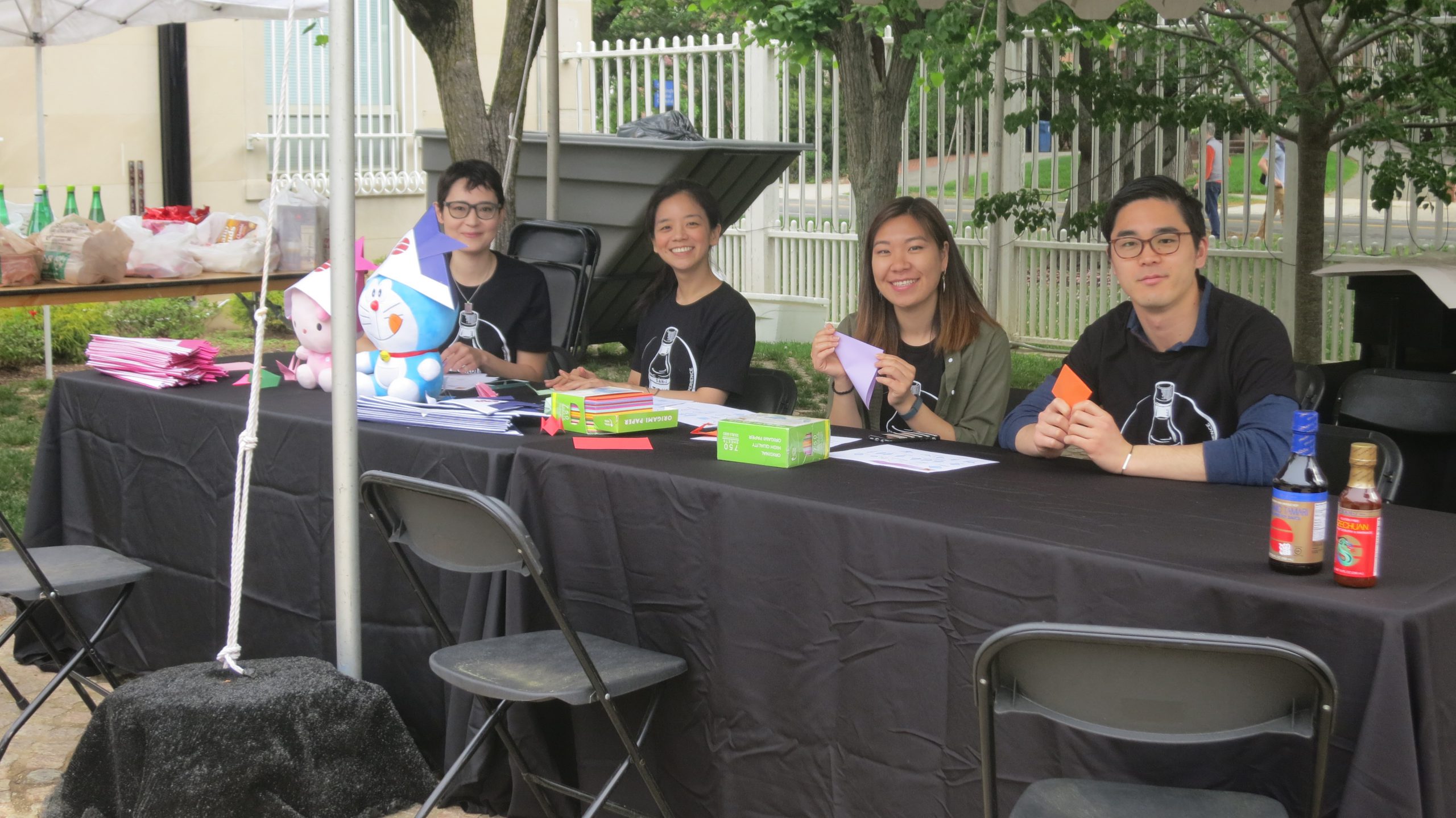
The much-anticipated calligraphy station was so popular, it had it’s own line wrapping itself. This calligraphy is everyday handwriting to the Japanese. To non-Japanese people this alphabet looks foreign and stunning like a masterpiece. Everyone wanted their name, a symbol of significance, or just their letter on a piece of paper. Watching this art in creation looks just as stunning, using a massive paint brush and pan of ink, managing to not spill, and write their beautiful alphabet on paper for others to enjoy.
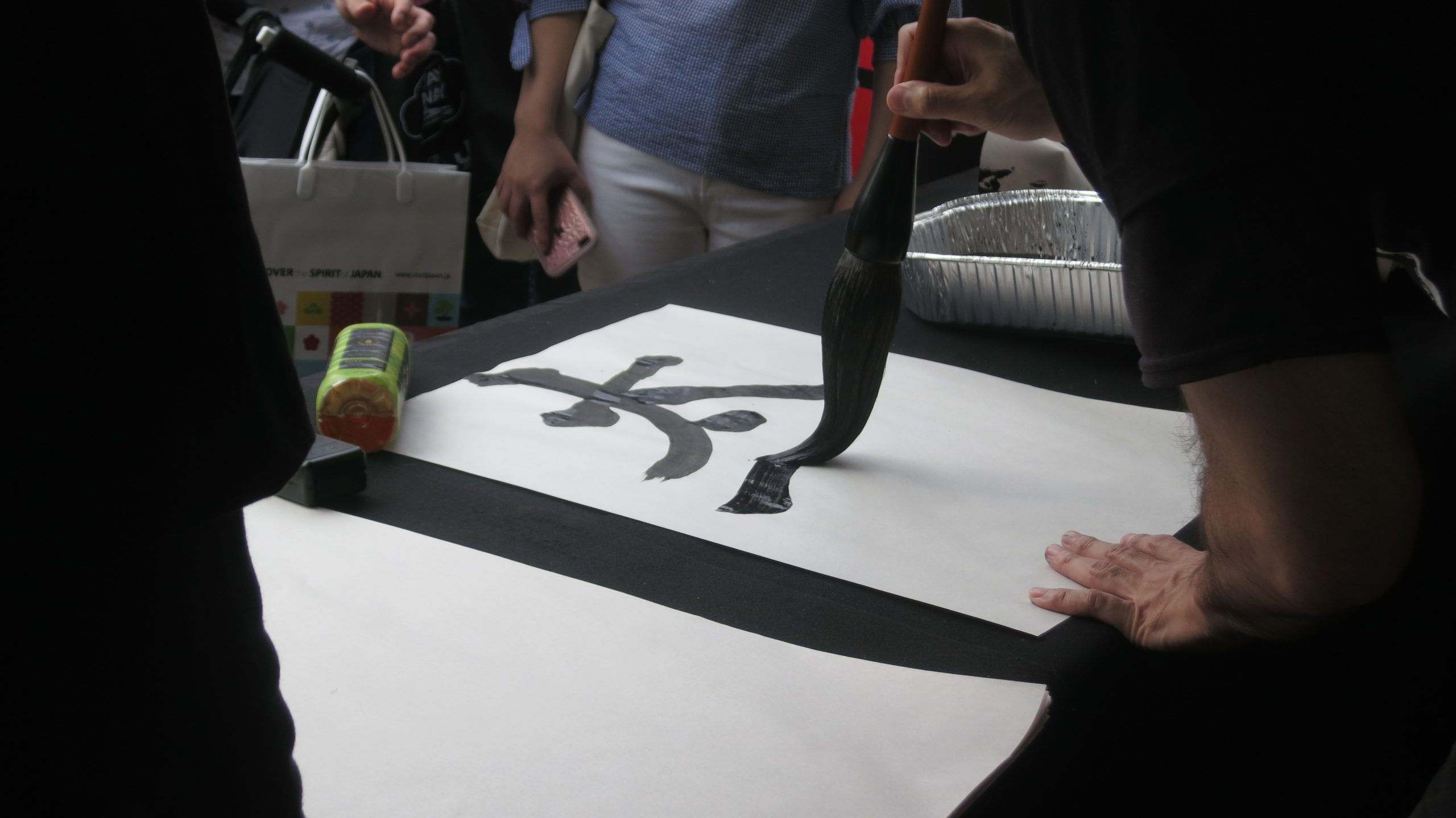
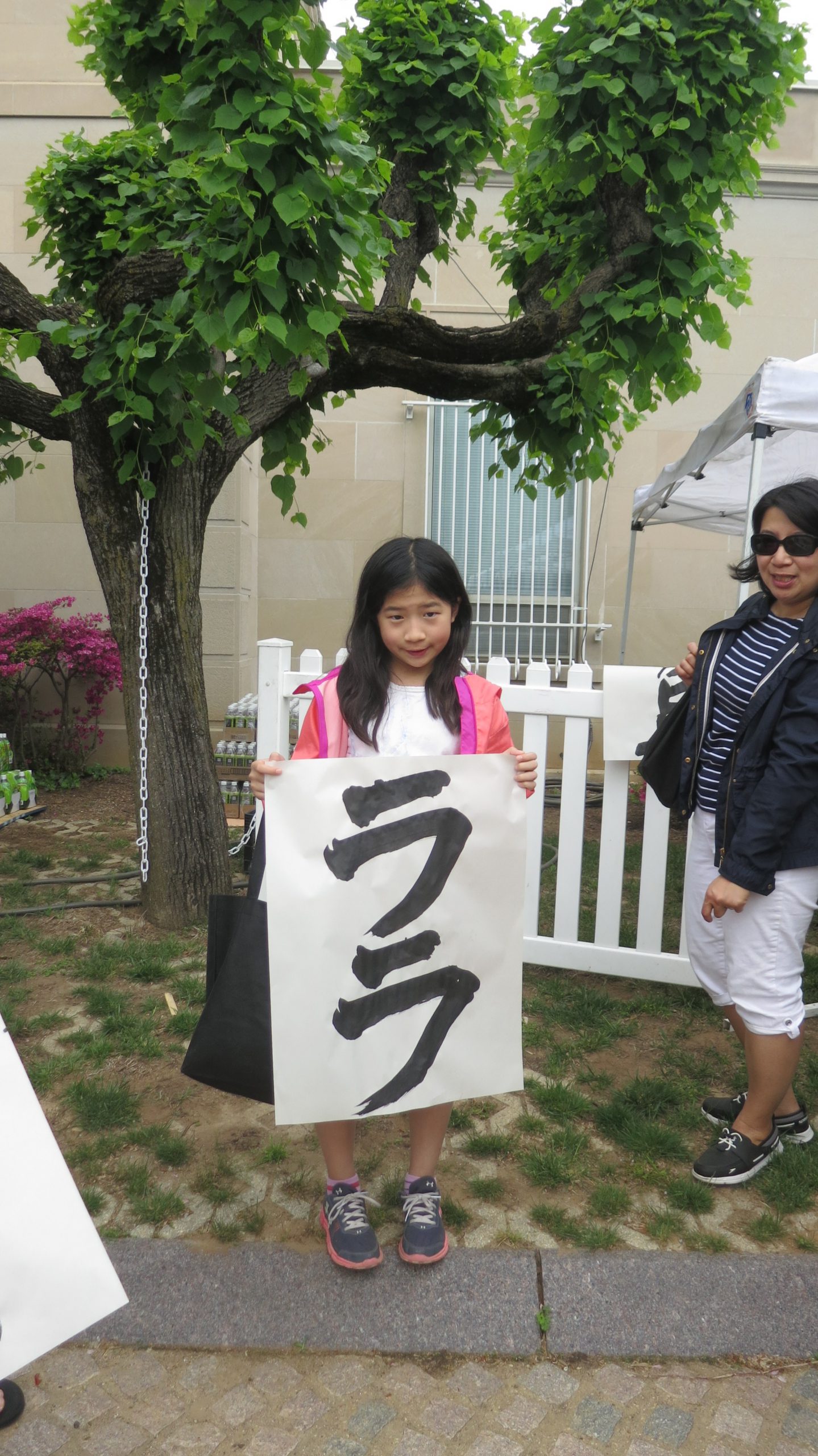
When the presentation put on by the Japanese Embassy began, a silence fell over the crowd to watch the dance called Eisa and hear what this dance/performance was about. The dance is performed at Bon festival and is done to honor the spirits of their ancestors. As the dancers/performers came on to the little field of grass in a powerful sweep of music and call—they were holding drums and danced in a wide range of motion that was eye catching and graceful.
The bold, eye catching colors for the dress attire these performers wore added a merriment of its own showing that it was a dance of joy and celebration. The drums beating along with the shout of Japanese language this dance kept the crowd memorized till the end of each performance, which always resulted in applause.
When the children performers came out on the grass many faces lit up in the joy of seeing them perform and the children’s own joy upon their faces.
At the end of each set of performances the announcer always had the public join in on the last dance. This dance was one of everyone’s involvement. People were happy to join in and wave their hands upon instructions and dance around in this joyful style.
The dance was explained as being a greeting dance, which was perfect for showing the public the Japanese culture and their beloved lifestyle and traditions.
Many people were pleased and surprised that we are located in Virginia, only an hour and a half from the event. The crowd never ceased from the minute the gates opened at 10am till they officially closed at 4pm.
The crowd in much contentment ate the food they craved and raved about, watched in amazement and awe the skill in origami and calligraphy, and happily joined in the performance of Japanese dancers and performers.
Learn more about the event here, and be on the lookout next May to join in on the fun!
One of the wonderful things about being a regional sales manager for San-J International is having the opportunity to visit the country of Japan. In April, Dan Kettman, our Midwest regional manager, Mike Tuleya, our Broker of the Year, and I all made the long journey west for a five-day visit.
Day 1
A trip to a foreign land can be daunting when you can’t speak their language. The three of us could only say a few words in Japanese: Kon nichiwa for “hello” and arigato for “thank you.” Mike, the most fluent of us three, could say one phrase with great confidence – his daughter taught him to say, “I am a pretty little girl.”
After sixteen hours in the air, and various airport connections, we finally arrived at Tokyo’s Narita Airport. But the fun didn’t start yet – it took over an hour to collect our bags, clear customs, and buy bus tickets to our hotel. Here’s a tip: don’t practice your Japanese bowing in the public bathroom mirror. It can be embarrassing if caught.
We then had an hour and a half bus ride to our hotel, and finding the right hotel was a bit of a challenge. There were three hotels with a similar name as ours—all of them were called Prince Something or Something Prince and they were all located next to one another. But it worked out and we found our “Prince.”
One thing you will notice immediately about Japan is they have excellent customer service, much better than anywhere else we’ve traveled to. They totally go out of their way to help in any way they can. For instance, after checking in at the hotel, we started to head to our rooms with our luggage and the hotel attendants literally ran after us to carry our bags for us. Each of us weighs over 200lbs, while they weighed about 90lbs, but they refused to let us haul our own stuff. And the hotel attendants take off their tiny shoes prior to entering your room.
So after nearly nineteen hours of travel time, we finally made it to our rooms, showered, steamed our severely wrinkled suits, and rushed downstairs to grab a taxi to have dinner with our Japanese co-workers.
Our gracious hosts, as is their custom, ordered our dinner which consisted of some sort of noodle soup, beef tongue, raw scallops, squid, pig intestines, sliced octopus and, thankfully, some good ‘ole beef steak. You haven’t lived until you’ve chased a pig intestine around your plate with chopsticks. Welcome to Japan!
Jet lag is a crazy thing. Your mind and body have no idea what time it is or whether you should be awake or sound asleep. We were all wide awake at 3:00 AM, Japan time, checking emails, calling home, etc. We had no idea which was more appropriate at that hour: cereal or pig intestine? Juice or sake?
Day 2
The next morning at breakfast, we noticed some of the fruit in Japan is a different size than ours. They have tiny strawberries and huge grapes. Who knew? After breakfast we ventured out to explore Tokyo.
The first thing we noticed is people walk on the opposite side of the sidewalks than Americans do. They drive on the left as well.
The second thing we noticed is that so many people wear white surgical masks. A rough guess is around 20% of the Japanese we saw that first morning were wearing masks. Google to the rescue: Japanese wear the masks to help with allergies. It looks like everyone is an off-duty surgeon who forgot to remove their mask. But it’s very practical and we saw it everywhere we went. By Day 3 we were each ready to try the masks because our allergies flared up.
Take a long walk in almost any U.S. city and you will see graffiti, litter, and homeless people. Not in Tokyo. We saw none of that. None! Everything is clean, no graffiti or garbage anywhere. And what’s odd is you don’t see trash cans anywhere. There were no public trash cans, so our trash went into our pockets until we got back to the hotel.
One familiar site is the 7-11 store, seemingly on every corner in Tokyo. We learned they carry totally different food items than our stores do. For instance, they have no Slurpees, but if you’re craving a delicious eel-to-go, they have those!
The remainder of our day was spent walking all over Tokyo and enduring a non-stop rain storm. But the Japanese are very prepared for rain; they have free umbrellas at most of the hotels. You just take one and leave it at the next destination. We thought they were free to keep…
Day 3
Being inside a train station in Tokyo is an incredibly overwhelming experience. Take any U.S. train station and multiply its foot traffic by two or three. It was that crazy! There were thousands of zig-zagging, speed-walkers hurrying off to work. If we slowed down even for one second we created a huge traffic jam. It was major sensory overload!
We braved the chaos to buy tickets for the Bullet Train to what we assumed was the correct location (Kyoto) and hoped for the best. At 200 mph, if you go to the wrong destination, at least you’ll get there really fast.
We made it to our train, confirmed it actually was our train, and then took our seats for a two-hour ride. Everyone was very quiet on the Bullet Train. They all worked on their laptops, messed with their phones, or took much-needed naps. The food and beverage cart went up and down the aisle but nobody ordered anything. And if we spoke above a whisper we felt like we were being rude. The Bullet Train was super clean and the ride was unbelievably smooth. But a party atmosphere, it was not.
At 200mph things move by pretty quickly, but the one thing we did see a lot of were golf ranges. Tons of them were along our train route. But, funny thing is, we saw zero golf courses. In fact, the whole five days we were there we didn’t see a single course.
The Kyoto train station is spectacular! It’s huge and grand and full of action. We’ve never seen a better train station. Loads of restaurants, bars, shopping, and there’s a garden terrace on the roof overlooking the city.
While our hotel room in Tokyo was a typical American-style room, we were not so fortunate in Kyoto. We were forewarned when we read on their hotel web page that they had “fuss-free” rooms. We weren’t quite sure what that meant… until we entered the rooms. Each room was maybe 8×8 ft. It was so small we couldn’t unfold our suitcases, which was fine, because there was no closet.
As small as our rooms were, though, they were grand compared to the bathrooms. You could accomplish a lot in there without ever having to take a step.
Though the accommodations were sparse, the service was truly fantastic. The staff was super friendly and we ended up loving the hotel. Unlike our Tokyo hotel, which had mainly Japanese guests, this property was filled with Europeans. Kyoto is a bigtime tourist town and there were many buses at our hotel.
After a quick nap we ventured out into the Kyoto nightlife. Like our hotel rooms, we found all of the bars and restaurants to be very tiny. These places sat maybe 10-12 people. The server was owner, bartender, chef, and karaoke DJ. The typical place was around 5×20 ft. with every inch being utilized.
We found one place and hung out for an hour or so. Dan and Mike did some karaoke with a few locals. It wasn’t easy on the ears, but fun just the same.
Further exploring brought us to another establishment where we befriended two locals who spoke zero English. Via the beauty of Google Translate we were able to communicate with these two for over an hour and became good friends. It was really a beautiful experience.
Day 4
For breakfast, we ordered two of everything due to the small portions. Then we decided to be typical tourist and head out to look at the temples of Kyoto.
Each temple was more beautiful than the one before. Some were simply breathtaking. These incredible structures are thousands of years old and we felt so humbled to be in their presence.
After the temples we decided to head downtown to find our new friends from the bar. They gave us the name of the store they worked in, but when we arrived neither of them were there. So, we left the store and followed a flow of people down one alley, then another, and suddenly we found ourselves at the start of an incredible mile-long alleyway filled with shops and food stands.
It was amazing! If you ever have a craving for octopus-on-a-stick, this is your place. Every kind of seafood you can imagine, cooked or raw, was available.
There were hundreds of vendors, maybe thousands. This was a weekday but the place was packed with both tourist and locals. Food is a huge part of Japanese culture, and they take it very seriously.
By now, you would think we’d be more careful regarding what food was being served, but, sadly, we were not; That plump, juicy chicken on the kabob was, in fact, not chicken at all, it was garlic cloves. And, how about the yummy looking pasta in the huge bowls? Nope, at one end of each “noodle” was a pair of beady little eyes balls. They were some sort of white eel.
At the end of the alley was another alley filled with bars and restaurants and we found our way to a little bar up a steep flight of stairs. The place was nearly filled to capacity, which is to say there were ten people there. For the next few hours we befriended people from Spain, the US, and Germany, and had a blast. Everywhere we went in Kyoto, everyone was a in a great mood and so much fun to be around.
After leaving the bar we roamed around Kyoto and saw many awesome sights. We were told to go to Japan in the spring when the cherry blossoms are blooming, but we really didn’t care too much about that. I mean, you know, macho men don’t care about flowers and stuff. We were wrong… very wrong. These trees were strikingly beautiful.
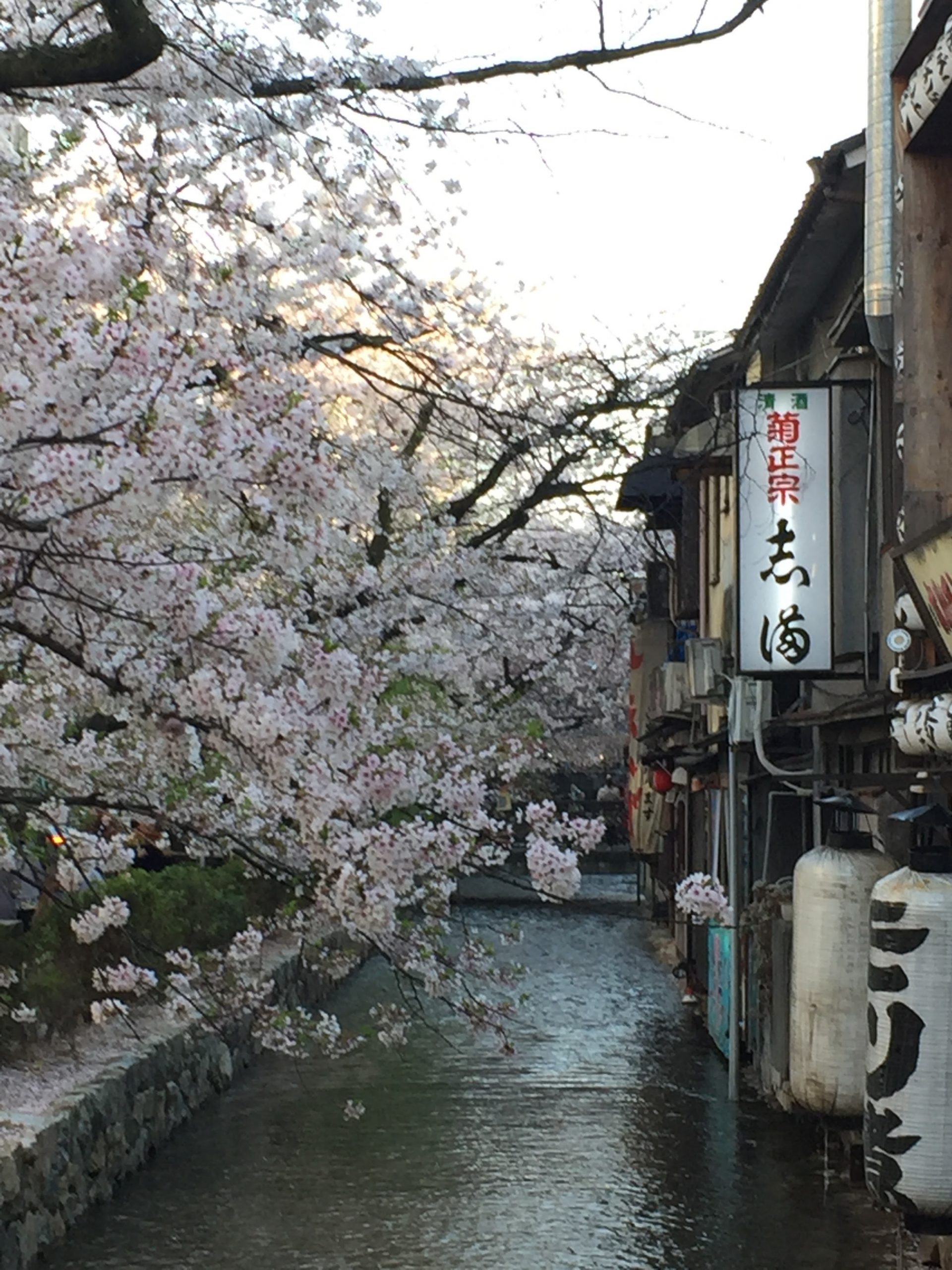
Day 5
We took a peek at our hotel breakfast buffet and the choices were overwhelming: mackerel, fish pate, french-fries and beef stew. Where’s a waffle when you need one?
We fell in love with Kyoto and hated to leave, but it was time to head to our final destination of Nagoya, which is about thirty miles from our factory in Kuwana. By now, we were Bullet Train veterans so we bounded through the train station like seasoned Japanese travelers (we almost boarded the wrong train, twice.)
There are many wonderful things to love about Japan but their furniture is not one of them. From the time we arrived we noticed they use very little cushioning. The beds, chairs, couches, everything is hard. The seats in the train station are no different, very hard and uncomfortable.
In addition to missing cushy furniture, we missed forks and spoons. Chopsticks can be novel and fun for a few days, but after a while we sort of got tired of trying to eat soup with them. Want to kill an hour? Try eating a slippery noodle with a chopstick!
An hour later we were at the Nagoya station where our hosts, Taka and Hiro, met us as we departed the train. Both of them lived in the U.S. for many years working at our factory in Henrico, Virginia, so they speak excellent English. We greatly appreciated having them as our hosts.
Another short train ride brought us to Kuwana, home of our sister company, San-Jirushi. By the way, our name, San-J is derived from San-Jirushi. We shortened it to San-J when we started importing the U.S. many years ago. The company was founded in 1804 and San-J’s president, Takashi Sato, is eighth generation! Pretty amazing history.
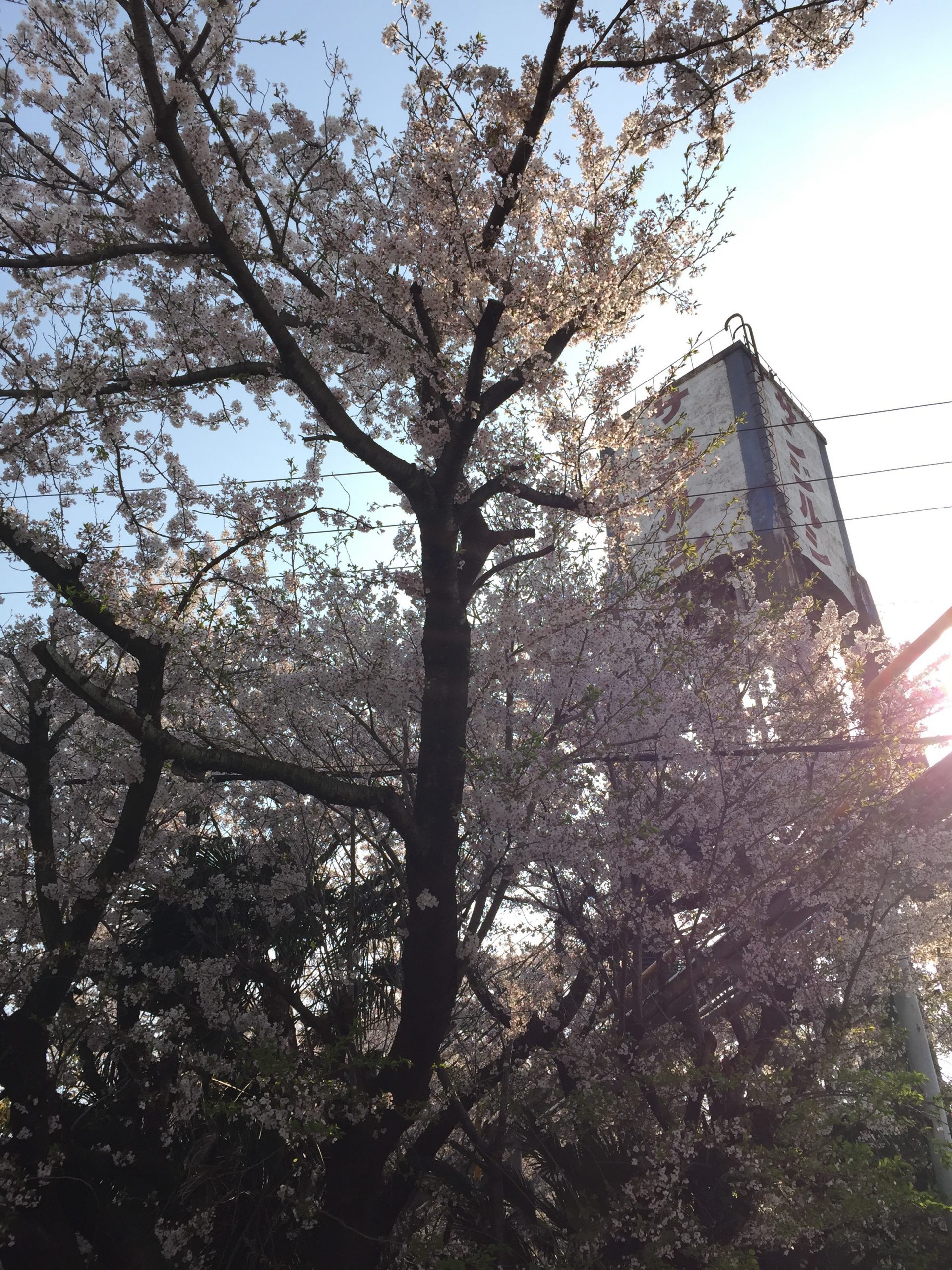
We spent some time with Taka and Hiro going over a few new flavor ideas for the U.S. and learning about some of the San-Jirushi products that we don’t currently sell in our country. Miso paste, for instance, is huge in Japan and San-Jirushi is one of the category leaders. After the meeting we took a tour of the factory and met with dozens of employees working in various positions. Everyone was very accommodating and happy to answer our questions. It was an excellent afternoon at the San-Jirushi factory.
We then headed back to Nagoya to check into our hotel (large rooms!) and to get ready for dinner with Taka, Hiro and a few more hosts from San-Jirushi.
After five days you’d think the jet lag thing would subside, but it never really did—we were perpetually tired. We thanked our awesome hosts and soon headed back to our hotel for our final bedtime in Japan. But before separating to our rooms we reflected on some things we learned while in Japan:
We had a blast experiencing Japan and its wonderful culture and people. We highly recommend a trip to Japan to everyone!
In Japan, cherry blossoms are praised for more than just the arrival of spring. Also known as sakura, cherry blossoms are symbolic of the beauty and mortality of life, paired with optimism of a fresh start.
As my father has always been so passionate about photography, we have so many photos that captured our family memories all year around. Sakura appeared in the background of many of our spring photos. Such as my entrance ceremony for grade school, junior high school, and high school. Family picnics under cherry blossom trees. And walking my little Japanese Shiba dog, Chibi, in a rice field.
With the sakura season representing a fresh start, it’s appropriate that April marks the beginning of the Japanese fiscal and school year, unlike the American school year beginning in the fall.
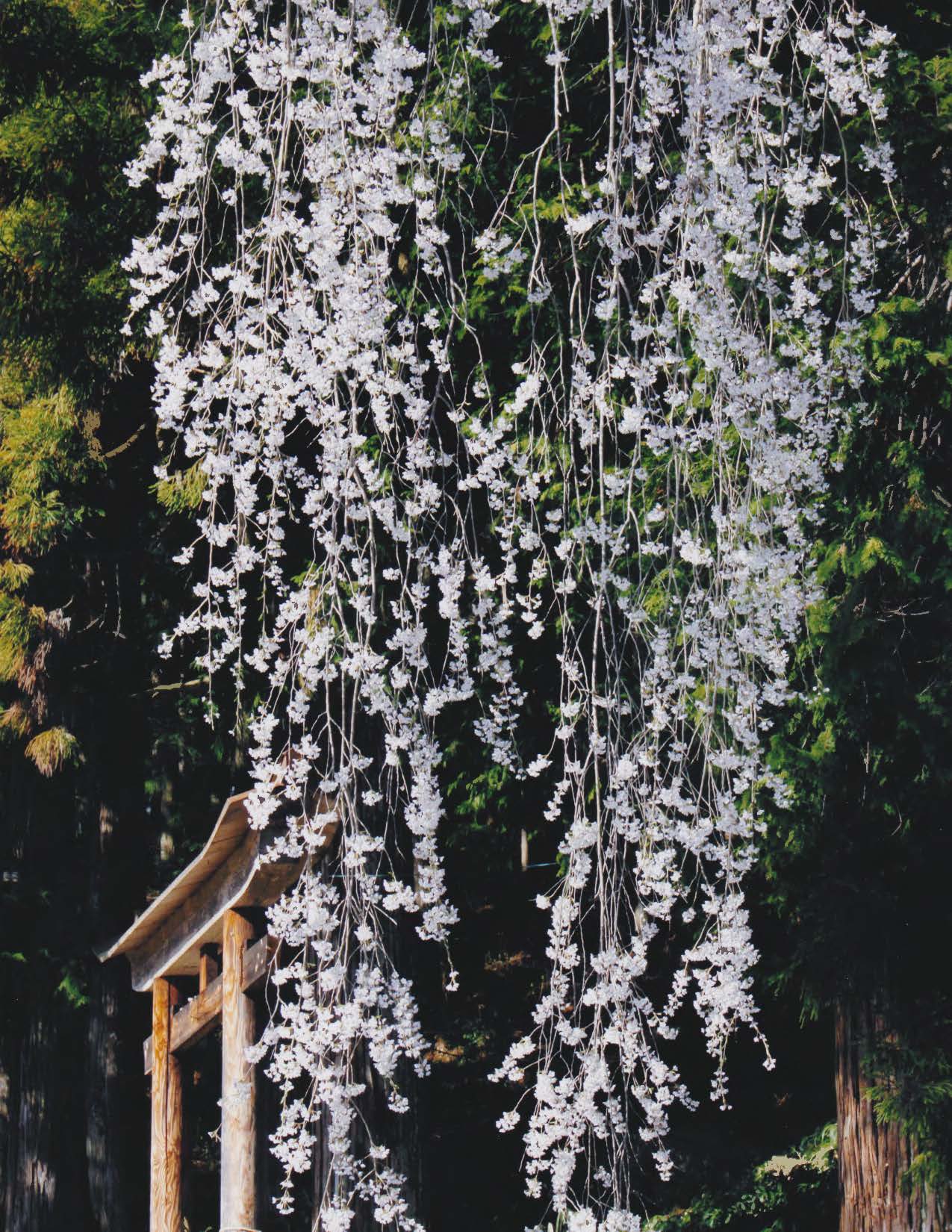
Photos by Makoto Tanaka
Sakura blossoms start budding mid to late March in some regions, and as late as May in other regions. The blooms only last between one and two weeks, which echoes the fleeting nature of life. Since many events and customs revolve around the brief bloom period, there is a sakura forcast dedicated to sharing when blooming will begin in each region of Japan.
Once the cherry trees start to bloom, celebrations are had, day and night. These flower-viewing parties are called hanami and are a way to slow down while appreciating the cherry blossoms with family, friends, and colleagues. The best spots for Hanami are where you can surround yourself with the fully bloomed cherry trees, like city parks, gardens, and riverbanks. In order to save a spot for a picnic lunch, people will start arriving to the park early in the morning. Some companies send an employee out to reserve a spot for the rest of the company who will arrive after work.
No celebration is complete without food and drinks. We eat bento meals with various snacks and sweets, all while enjoying fresh air under the sakura. Bento box lunch is especially delicious when eaten under the cherry trees as a family picnic. My mother’s bento was the best. It always had three kids’ favorites: Karaage (Japanese fried chicken), Ebi- fry (panko breaded fried shrimp), and Hambāgu (Japanese style hamburger steak). She also made Tamago-yaki (rolled omelet) and Onigiri (rice ball), which are the essential for a Japanese bento.
I have so many memories through the years of sakura seasons, but my biggest memory is the big cherry tree that we had in the backyard. Most of the cherry trees that you enjoy for their flowers during hanami don’t bear fruit, but ours did! They were so sweet and tasty, and I was so excited about the coming of spring because that meant I got to eat our sweet cherries! I became popular among friends at school because I invited them to my house for cherry harvesting parties.
Each year when the tree started bearing fruit, the war between my father and the birds began. It’s not only humans who want to enjoy the ripened, juicy cherries. And birds are the ones who can spot the cherries first. As soon as my father detected the arrival of birds, he ran to the backyard to scare them off. It was comical how they fought each other, creating quite the spectacle for my mother, sister and I. He finally ended up covering the tree with a fine net as his strongest defense.
Sadly, my parents had to cut down the cherry tree when their house was expanded and my favorite tree is not there anymore. However, every spring, the memory of the tree comes back to me and warms my heart.
I have a weeping cherry tree in my backyard now but it is too small to eat bento underneath. When it grows big enough, I’d like to start our family hanami tradition.
If you’d like to enjoy a little bit of the Japanese cherry blossom traditions in the states, the Sakura Matsuri Japanese Festival held as a part of National Cherry Blossom Festival in Washington DC would be a great event to go to. Washington DC is full of cherry trees that were gifted from Mayor Yukio Ozaki of Tokyo in 1912 to honor friendship between the United States and Japan. More than 3,000 trees were gifted and planted!
San-J is pleased to support this event, marking our seventh year to participate. If you make it out, stop by to say hi and enjoy some tasty treats!
If you can’t make it to Sakura Matsuri, try making your own Karaage to enjoy under a blossoming cherry tree.
Ingredients
2 lbs. Chicken thighs or breast, cut into 1-inch pieces
1 ½ Tablespoons Fresh ginger, grated
2 cloves Fresh garlic, grated
4 Tablespoons San-J Tamari Soy Sauce
2 Tablespoons Sake
2 Tablespoons Mirin
1 cup Potato starch or corn starch
Canola or vegetable oil (for frying)
1 Lemon
Directions
Mix the ginger, garlic, San-J Tamari Soy Sauce, sake, and mirin in a large sealable container or bag. Add the chicken, mix to coat evenly. Seal and marinate the chicken for 30 minutes to 1 hour.
Heat the frying oil to reach 360ºF.
Put the potato starch in a bowl. Add the marinated chicken in small batches, shaking off excess liquid, and tossing to coat each piece evenly.
Shake off excess starch and fry the chicken in batches until the surface is golden brown and the chicken is cooked through. Place the fried chicken on a paper towel lined rack to remove excess oil and serve with lemon wedges.
The history of our business goes back to 1804 in Japan. We opened our sales office in the USA in 1978. After nine years, we built our brewing facility in Virginia and since then, we’ve been selling our Tamari made in the USA.
We get many visitors to our facility, and we’re often asked why we chose Virginia as the location to brew our Tamari. It was my father who made the decision when he was president of San-J, and there are several benefiting factors that led him to this decision.
The climate of Virginia is suitable for brewing. It’s similar to the climate of Japan with four seasons and high humidity. So he determined that our brewing experiences in Japan could be utilized in Virginia as well. Virginia’s climate is so ideal for brewing that there are 248 wineries and 124 beer breweries in the state. The number of wineries is the second largest in the East Coast, following the state of New York. Our former production director was making wine as a hobby and now that he’s retired, he has opened his own winery!

Our brewing facility is located in Henrico where I-95 runs north and south, and there is also Amtrak. The Amtrak railroad branches off directly to our facility. In addition to that, Port of Virginia in Norfolk is the biggest port in the east coast. These assets enable us to deliver our products efficiently and avoid longer lead-time.
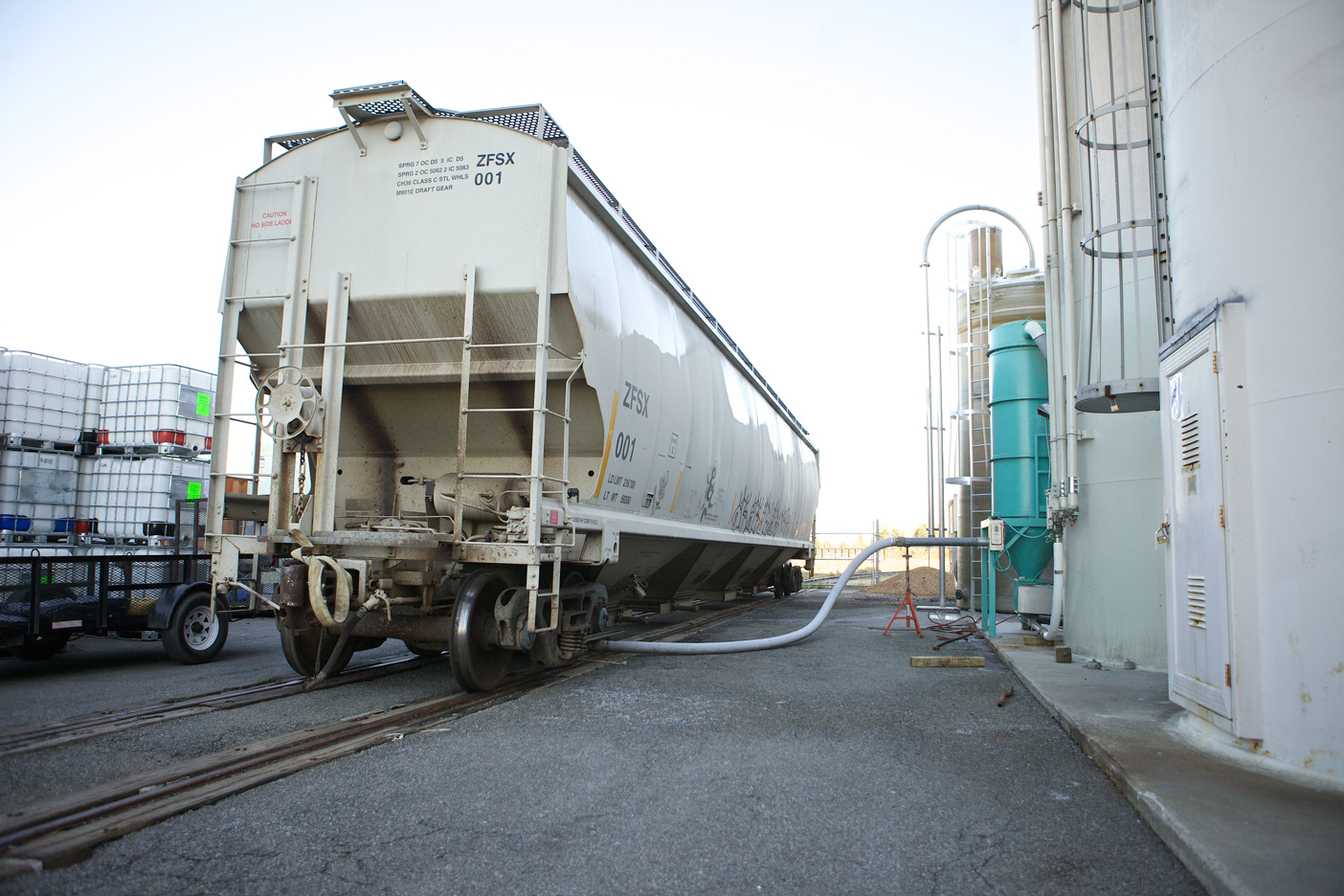
When we started marketing our products in the USA forty years ago, the awareness of Japanese cuisine was low. We could have built our facility in California where many Japanese people lived, and therefore Japanese food was more popular there. However, we had a concern that if we depend on consumption of our product within the Japanese community, it could become more difficult for us to go into the mainstream market. We came to the USA so that all people would be able to enjoy our Tamari Soy Sauce. Therefore, we chose Virginia as our home base to build our brewing facility. It was a more challenging route but it has allowed us to build a closer relationship with this country.
Tamari soy sauce has a long history. There are different theories but it was first made over 500 years ago. It is said that Tamari is the origin of Japanese soy sauce. The Colony of Virginia was the first permanently settled English colony in North America. Berkeley Plantation, the Virginia’s most historic plantation is just 15-minute drive from our facility. That was where settlers observed the first official Thanksgiving in America. My father wanted to continue our brewing tradition in this Virginia where it is rich in tradition.
As we’ve experienced such great growth over the past several years, we’ve begun expanding our facility. I have no doubt that our success had much to do with my father’s decision of choosing to build in Virginia.
Our facility expansion started last fall. As a matter of fact, we considered building our second facility in another state. But the state of Virginia has supported our business since our startup in the American market and we’d like to give back to the community.
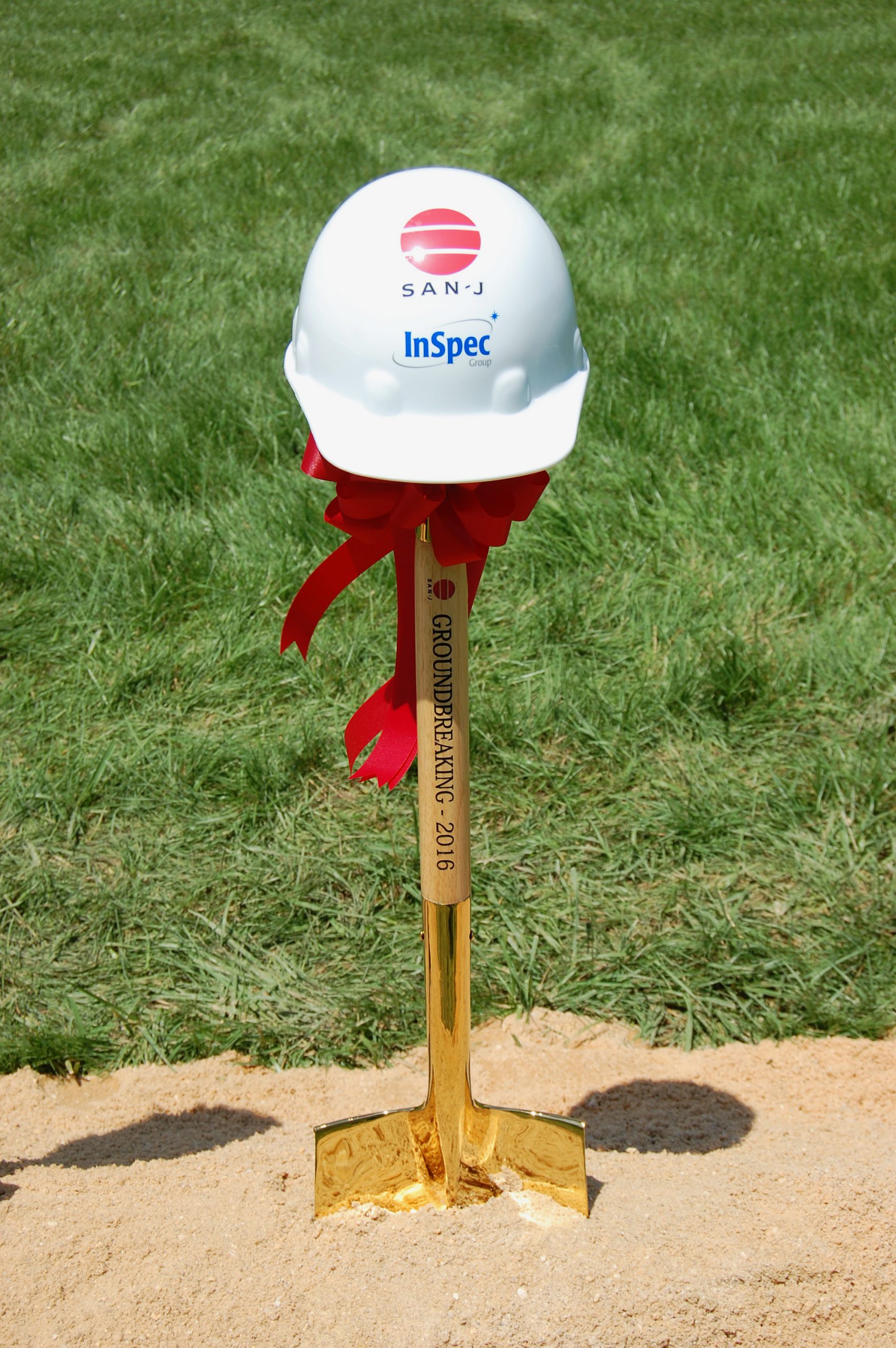
I had the pleasure of meeting with Governor Terry McAuliffe of Virginia a few months ago, and I was excited to report the successful start on our facility expansion. Our local Virginia expansion will bring advanced manufacturing jobs to the community where we feel so welcome. We’re pleased to contribute to a growing economy and a loving community.
Fermentation is a critical process to brew our Tamari soy sauce. I had the opportunity to talk about fermentation at a recent event, Secrets of Washoku. It was held by The Japan Information & Culture Center (JICC), which is part of the Embassy of Japan in Washington DC. The JICC’s goal is to promote better understanding of Japan and Japanese culture by providing information and events to the American public.
Local guests from the Japanese food industry were gathered to share the unique qualities of traditional Japanese cuisine and food culture with the greater Washington DC community. The result was a two-part series covering different types of Japanese food.
The maximum capacity for the event was 140 people. Registration was full just one day after the Embassy of Japan announced the event. I was delightfully surprised to find out that so many people have an interest in fermentation. The event started with my presentation about soy sauce, which is one of the most well known fermented foods of Japanese cuisine. Fermentation is a process in which sugars and carbohydrates are broken down into simpler compounds through the use of probiotic microorganisms. Throughout Japan’s long history, fermentation has been a prevalent method of preserving food, creating new flavors, and improving health. With the process of fermentation and aging we are able to create a rich and smooth tasting tamari. I would be weary of any tamari that is created with shortcuts to speed up the up to 6-month process.
We also heard from Mr. Utagawa, an owner of Japanese restaurants in Washington DC called Daikaya and Sushiko. He talked how fermented ingredients are used in Japanese cuisine. Following the presentation, we had a question and answer session. There were so many interesting questions from attendees, which showed a high level of interest in fermentation and Japanese cuisine.
Make Your Own Tamari Kit
I brought tamari making kits as a gift for attendees. They’re similar to beer making kits you can find in stores. This was the first time we’ve made a kit like this and I was not sure if you can create a flavorful Tamari with this kit as tamari making requires a long period of time and labor to shake it daily for proper fermentation. I was not sure if people would actually like to try making their own Tamari, but 70% of the attendees requested for the kit! I’m really looking forward to hearing about their Tamari making experience.
For more information about The Japan Information & Culture Center (JICC), visit their website.
Adding flavor to a gluten free diet can be quite an undertaking for an individual who is newly diagnosed with celiac or gluten related sensitivities. At the Gluten Free and Allergen Friendly Expo in Secaucus, NJ we had the opportunity to speak to many of the 3800 people that attended. Actually, I think we may have talked to them all twice.
Leaving TD (Tiny Dancer) aka Mookie my little dog behind and my sister in tow, I headed out to the Meadowlands Exposition Center to set up our booth. We laid out the tablecloth, hung up our banner, and displayed all the sauces one by one. Then we waited for the doors to open…
There were so many attendees seeking information, knowledge, and tasty treats. “Is this Gluten Free?” “Yes it is.” “What about nuts like peanuts and tree nuts?” “Well technically a peanut is a legume” … “What about sesame? Mustard? And soy?” And then our most common exclamation, “Where can I buy this awesome sauce?!” We directed them to which sauces they could have based on each individual’s dietary needs. The atmosphere was happy like a kid in a candy store; delicious food made with them in mind.
Dietary changes can cause confusion, depression and chaos. The expo is a great opportunity to sample new gluten free products and find what works for you, define your palette, and choose which food you like or dislike before purchasing. People were able to try all seven San-J Asian Cooking Sauces. If they didn’t know which one to try first I would ask “Do you like spicy or sweet?” and start from there. Spicy Szechuan was a favorite among many to give a gluten-free dish a kick with lots of flavor. If they preferred sweet, we recommend everyone’s favorite Teriyaki or our newest sauce, Mongolian. “I’m so happy I can have Asian food again,” a lady told me. “What stores carry these? I love them all!”
My sister and I handed out samples of our “Tamari to go” portion packs. “I can have sushi! I had gluten-free sushi at a restaurant but they didn’t have gluten-free Tamari/soy sauce,” someone exclaimed. My response, “Huh? Who does that?” Then we gave her a Tamari to go plastic carrying case to put the Tamari portions packs in, and I think she left right then to order sushi! “I don’t have to carry my Ziplock bag with packets in them or my bottle to the restaurant. Those cases are genius!” Some restaurants won’t let you BYOBOT (bring your own bottle of Tamari) so the cases were a hit!
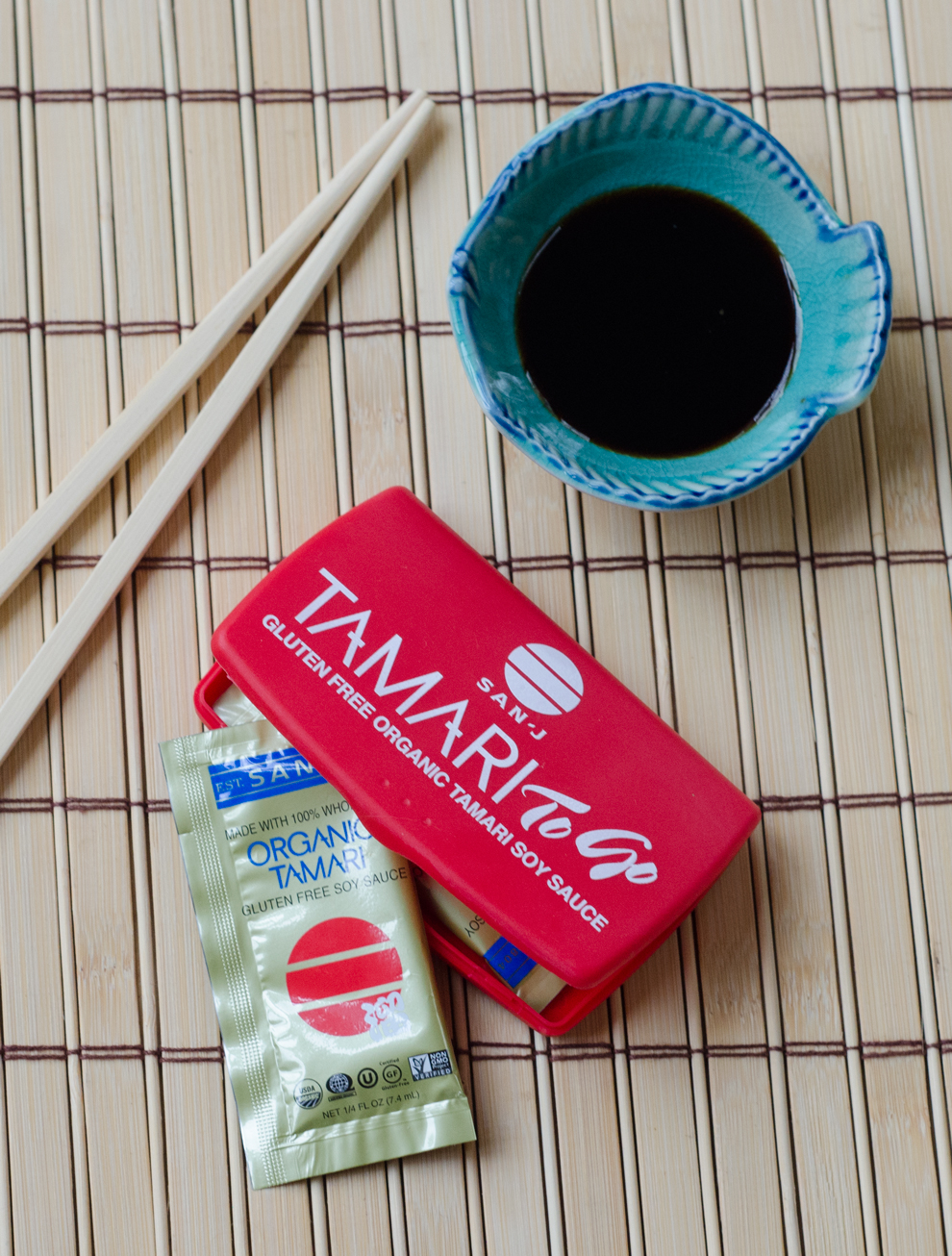
Someone approached our booth and said, “You saved my life! Now I can eat Asian food again, thanks to San-J” This was one of the most gratifying compliments I heard. Many people walked by and said how much they love our products and thanked us for making them. Gluten-free products have come a long way. San-J was there in the beginning providing gluten-free diets with lots of flavor and taste!
We love participating in these gluten free, allergen friendly shows because they give us great opportunities to talk to people in person. It’s so rewarding to know that our products are loved by so many people. They also give us opportunities to discover people’s needs, wants, and thoughts on how we can better contribute to improve people’s lives. Thank you everyone who has come to our booth and talked to us. We are looking forward to connecting with even more people next year!
Interested in going to these shows? Here are some of the great gluten free, allergen friendly shows!
Gluten Free Allergen Friendly Expo
Gluten Free Food Allergy Fest
Learn more about San-J gluten-free products.
My gluten-free journey started over 20 years ago. It was not a journey I ever expected to make and I could never have anticipated just where this journey would take me.
Like a lot of people, I spent years trying to solve certain medical issues with no result. I suffered from migraine headaches – at the time of my gluten sensitivity diagnosis I was having one migraine a week, each one lasting three days.
I had seen doctors, chiropractors, nutritionists, and dieticians to try to find the cause of the headaches. With each new practitioner, my hopes would be lifted only to be dashed once again when nothing resulted in positive change.
A little over 20 years ago, I went to see a chiropractor who was new in town and was getting rave reviews from friends and associates of mine. I actually didn’t go to him for my headaches, as I had since given up on trying to find a solution for them. Rather, I went because my shoulder hurt. I had to fill out the standard medical history forms and when he read about my migraines, he said he thought he could help me. I was reluctant to hear what he had to say, as I didn’t want to be disappointed one more time. But he was genuine and sincere and for some reason I trusted him. So I agreed to give it a shot – I told him I would do everything he recommended and would “wait and see.”
After some testing, he told me I had to cut wheat out of my diet – you didn’t hear much about gluten back in those days. I was skeptical – how could something as seemingly innocuous as wheat be the cause of such pain and misery? But I followed his advice to go wheat-free and the results were shocking. After only two weeks, I had my first migraine-free week in years. After six weeks of a wheat-free diet I felt great, had more energy, and had a whole new lease on life. I wish that was the happy ending of the story, but unfortunately my journey was not free of stumbles.
Growing up, we had lived in Asia for a few years and I was particularly fond of Japanese, Korean, Vietnamese, and Chinese food. I started to notice that every time I ate food from an Asian restaurant I would get a headache. I thought maybe MSG was the reason. I started to make the Asian delicacies at home, without any MSG, but I still got headaches. This was both puzzling and disappointing. I had already given up bread and pasta, did I really have to give up all Asian food, too?
You need to remember, this was in the days before we were all on the internet and, unfortunately, information was not so easy to come by. Also, there was not a lot of attention on gluten-free back then. Somehow, I stumbled across some information of hidden sources of gluten. Imagine my shock when I saw soy sauce listed! It never occurred to me that wheat would be an ingredient in soy sauce. This was a real eye-opener. It was at this point I realized that education was my friend and I needed to learn as much as I could about where gluten could “hide.” I started to read the labels on all my condiments as well as any canned or processed food. I found out that even whole turkeys could be injected with gluten!
Back then, the quality of gluten-free products such as breads and pastas was not very good, so I learned to substitute naturally gluten-free ingredients for those that were typically gluten-filled. I could still eat my yummy Bolognese sauce, but instead of putting it on pasta I would eat it with brown rice. I used thinly sliced eggplant or zucchini in place of lasagna noodles. Lettuce leaves stood in for sandwich bread and buns. In sticking to a naturally gluten-free diet, I was eating much healthier than the average American. But I still missed a lot of my Asian-inspired dishes.
Somewhere along the line I discovered San-J Tamari. Not only is the Tamari gluten-free, but I also preferred the taste to regular soy sauce; it is not as sharp, and is much richer and smoother. And as it turns out, Tamari (made without wheat like “regular” soy sauce) was actually the original. It wasn’t until soy sauce started to be commercially manufactured that the introduction of wheat came about.
I have always loved good food and dining out, and a gluten-free diagnosis is no reason why I should ever have to give up these things. Of course, education and preparation are key to staying healthy. A well-stocked pantry makes cooking at home easy and quick; I always have gluten-free cooking sauces on hand so I can whip up tasty meals in no time.
As a sushi lover, I keep a box of the San-J Tamari travel packs in the glove box of my car for when I am out and about and get hit with a sushi craving. My favorite local sushi spot even keeps a bottle of San-J Tamari in the kitchen for me, as does the only Chinese restaurant in my town that I frequent.
Committing to a gluten-free diet has changed my life for the better in so many ways. Today I have more energy than I did 20 years ago. I no longer suffer from weekly migraines, my joints don’t hurt, and I can live my life fully.
When people ask me if I miss gluten, the answer is a resounding “NO!” After all, who misses migraines?
The following is a recipe that illustrates the way I love to eat these days.
Slow Cooker Asian Pulled Pork with Pickled Vegetables in Lettuce Cups
For the Pork:
3 pounds boneless pork shoulder (also called Boston butt)
1 cup water
½ cup brown sugar
5 tablespoons San-J Tamari
2 tablespoons chili garlic paste
1 tablespoon grated fresh ginger
1 teaspoon freshly ground black pepper
1 teaspoon kosher or fine sea salt
Juice of 2 limes
4-6 tablespoons San-J Asian BBQ Sauce
For the Pickled Vegetables:
2 carrots
1 seedless cucumber
½ cup rice vinegar
1 tablespoon sugar
½ teaspoon kosher or fine sea salt
To serve:
Boston lettuce leaves
Sesame seeds
Cilantro leaves
Spray the insert of a slow cooker with gluten-free nonstick cooking spray. Place the pork inside the slow cooker.
Whisk together the water, brown sugar, tamari, chili garlic paste, ginger, pepper, salt, and lime juice. Pour over the pork and cook on low for 12-14 hours (or on high for 8-9 hours) or until the pork falls apart easily. Take the pork out of the cooking liquid, place in a large mixing bowl, and shred with two forks. Pour 4 tablespoons of the Asian BBQ sauce over the meat and toss to coat. Add more BBQ sauce, if needed.
Using a vegetable peeler, slice the carrots and cucumber into thin strips. In a small mixing bowl, combine the rice vinegar, sugar, and salt. Add the vegetables and let it sit at room temperature for up to 30 minutes or cover and refrigerate for up to 1 day.
Serve the pork in lettuce cups, topped with the pickled vegetables, sesame seeds, and cilantro leaves, if desired.
Appreciation:
My family started the Tamari soy sauce and miso business over 200 years ago, and we’re still a very small company. Our Tamari soy sauce is fermented with Japanese methods handed down for eight generations in my family, and we don’t take short cuts. We’re incredibly thankful that our products have been enjoyed by so many customers. The demand has increased even more rapidly in recent years. As a result, our production is facing the challenge to keep up with the pace to meet all the demands.
We’re doing our best to increase our production. We’ve begun producing on weekends, and some days we even run for a full 24 hours. Despite these efforts, we still are not able to fulfill all needs and it is beyond our capacity to increase production any more than what we currently have.
Facility Expansion:
To solve this situation, we have decided to expand our facility, using the land we have next to our current brewing factory. This growth is a big step forward and requires great responsibility for a small company like us. We discussed and made various plans numerous times. Since our facility has unique equipment and diverse requirements, we spent many hours researching how to meet these needs. Most specifically, our products need to meet the standard of not only their great taste, but also the strict standards of Non-GMO, Organic, Gluten Free, Vegan, and Kosher certifications. It requires very careful, detailed attention, more time, and added cost. But we believe these added resources are worth the energy when it comes to producing the highest quality product. With support of our staff, we finally finished the expansion plan and have started construction.
Groundbreaking:
Prior to the construction, we had a groundbreaking ceremony. It was a small service with only San-J staff and people who are involved in the expansion. After weeks of seemingly endless dreary weather during our planning, we were fortunate to have the encouragement of cheery, sunny weather for our groundbreaking day.
I began the ceremony with some words of appreciation, then we heard from the president of the construction company. We had a chief of the local Native American tribe say a prayer, and the ceremony ended with a speech by Miller, our project and safety compliance manager. Miller is always so upbeat and full of energy. I was moved when I saw him tear up during his speech. Seeing the staff work so hard these past months has been very moving.
It’ll take over a year to finish the construction. Since it takes up to six months to produce our Tamari, we will be able to deliver our Tamari produced in this new facility to our customers starting mid-2018. We are all thrilled that we will be able to increase our production capacity and fulfill the high demand for our products. Thank you for your support as we continue our efforts to provide the best tasting Tamari you can trust.